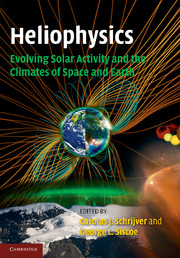Book contents
- Frontmatter
- Contents
- Preface
- 1 Interconnectedness in heliophysics
- 2 Long-term evolution of magnetic activity of Sun-like stars
- 3 Formation and early evolution of stars and protoplanetary disks
- 4 Planetary habitability on astronomical time scales
- 5 Solar internal flows and dynamo action
- 6 Modeling solar and stellar dynamos
- 7 Planetary fields and dynamos
- 8 The structure and evolution of the three-dimensional solar wind
- 9 The heliosphere and cosmic rays
- 10 Solar spectral irradiance: measurements and models
- 11 Astrophysical influences on planetary climate systems
- 12 Assessing the Sun–climate relationship in paleoclimate records
- 13 Terrestrial ionospheres
- 14 Long-term evolution of the geospace climate
- 15 Waves and transport processes in atmospheres and oceans
- 16 Solar variability, climate, and atmospheric photochemistry
- Appendix I Authors and editors
- List of illustrations
- List of tables
- References
- Index
- Plates
13 - Terrestrial ionospheres
Published online by Cambridge University Press: 05 April 2013
- Frontmatter
- Contents
- Preface
- 1 Interconnectedness in heliophysics
- 2 Long-term evolution of magnetic activity of Sun-like stars
- 3 Formation and early evolution of stars and protoplanetary disks
- 4 Planetary habitability on astronomical time scales
- 5 Solar internal flows and dynamo action
- 6 Modeling solar and stellar dynamos
- 7 Planetary fields and dynamos
- 8 The structure and evolution of the three-dimensional solar wind
- 9 The heliosphere and cosmic rays
- 10 Solar spectral irradiance: measurements and models
- 11 Astrophysical influences on planetary climate systems
- 12 Assessing the Sun–climate relationship in paleoclimate records
- 13 Terrestrial ionospheres
- 14 Long-term evolution of the geospace climate
- 15 Waves and transport processes in atmospheres and oceans
- 16 Solar variability, climate, and atmospheric photochemistry
- Appendix I Authors and editors
- List of illustrations
- List of tables
- References
- Index
- Plates
Summary
Introduction
Early investigation of the terrestrial ionosphere through its effect on radio waves resulted in description by means of layers, principally the D, E, and F layers, the latter subdivided into F1 and F2 (see Vol. I, Fig. 12.1). This terminology continues to influence our current concept of the nature of energy deposition in atmospheres, although the misleading term “layer” has given way to “region”. The term “layer” arose from the observation of systematic variation in the height at which the critical frequency of reflection occurs in ionospheric radio sounding; this method cannot detect ionization above the peak of a region, which explains the appearance of layers. Radar and spacecraft measurements now give a more complete picture of peaks and valleys and reveal the complex morphology of the ionosphere. Chamberlain and Hunten (1987) provide a referenced discussion of the historical literature.
An overview of the altitude dependence and variability of Earth's ionosphere is given in Fig. 13.1, showing the diurnal and solar-cycle changes and the locations of the named regions. Space and planetary exploration has also found that the Earth's ionosphere is unique, just as its atmosphere is unique, and for some of the same reasons as we shall touch upon in this chapter.
An additional historical artifact in terminology is the word ionosphere itself. Because the atmospheric ionization was discovered before the neutral thermo sphere in which it is contained, anything above the stratosphere is often referred to as the ionosphere, resulting in a common misconception that this region of the atmosphere is mostly ionized.
- Type
- Chapter
- Information
- Publisher: Cambridge University PressPrint publication year: 2010
- 2
- Cited by



